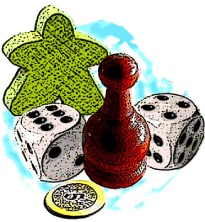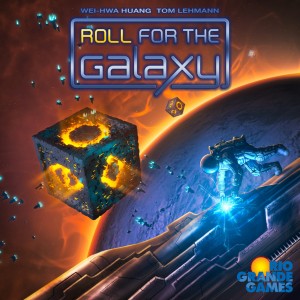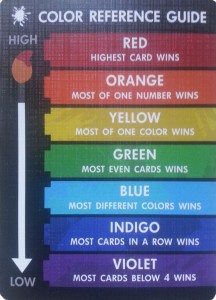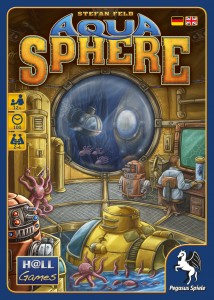Atlanta Game Fest 25: Day 1
I learned and played a lot of new games at Atlanta Game Fest 25. Day 1, Thursday, began with me teaching a few: Viticulture with a few of Tuscany: Tier 1 expansions, Sushi Go, and Abyss. Then the tables turned and I learned: Roll for the Galaxy, Red7, and Stefan Feld’s latest game, AquaSphere. Following are my first impressions.
Roll for the Galaxy is a dice game version of Race for the Galaxy. Your dice represent your populace, whom you direct to Explore for income, new worlds and/or new technologies; Develop the found technologies for abilities that can enhance your play; Settle the discovered worlds for additional dice and places to produce goods; Produce goods that you can later ship for money or victory points; and Ship those goods to Trade for income or Consume for victory points. These five actions are represented on the faces of the dice.
Players begin with 3 white home dice in their cup and 2 in your Citizenry on your player mat, a screen and a Phase Strip. You’ll also draw a faction double-tile and a home world tile from the start-tile bag. These tiles usually provide you with at least one additional die, sometimes more, in your cup or Citizenry.
To play, players simultaneously roll all of the dice in their cup behind their screens, then sort and assign them to the action(s) they want to perform this round. You can only choose one action that you’ll definitely get to do by placing it on the appropriate action on your Phase Strip; you can use any die to choose that action regardless of its face. Then assign the rest of your dice to the same or other actions according to their faces by lining them up above or below your phase strip, but not on it.
You may get to perform actions besides the one you selected, but that will depend on your fellow players’ choices. Indicate you’re ready by turning your dice cup upside down. Players will then simultaneously reveal their choices. Groans usually mean most people chose the same action, so won’t get to perform the other ones they wanted. Cheers the opposite.
Any dice you assigned to phases that weren’t selected this round go back in your cup, so all is not lost. Any dice you use go into the Citizenry on your player mat after performing the action in phase order. To get those dice back in your cup, you have to hire them from your Citizenry using income acquired from exploring or shipping goods or bonuses garnered from your developed technologies. Play continues until the victory points run out or a player has built a combination of 12 worlds and developments.
Roll for the Galaxy can feel very much like multi-player solitaire with players all executing their actions simultaneously and not paying much attention to what others are doing. This makes the game play short and quick. I think you could slow it down, play phase by phase, with each player indicating in turn what they’re doing thus improving player involvement. It’s a good way to introduce new players to the game, too. I enjoyed my two plays of Roll for the Galaxy during Atlanta Game Fest, but would need to play a few more times to decide if it’s a keeper. I definitely found it quicker and easier to learn and play than its predecessor Race for the Galaxy.
I only got to play Red7 once during AGF, but I definitely want to play it again. It’s a quick and easy player-elimination card game. It’s kind of hard to describe. The cards are numbered and each colored suit has its own winning rule. On your turn you have to play at least one card, either to change the governing rule and/or to add a card to those in front of you such that you now have the winning hand. If you can’t play a card to have the highest hand, or change the rules and optionally play a card to have the highest hand, you’re out. Your goal is to the the last remaining player in the game. It’s weird, but engaging.
In contrast to the simplicity of Red7, AquaSphere was initially almost overwhelming in its complexity. After playing it, it seemed simpler than it at first appeared. The board and bits are colorful and engaging, though they make the game look quite chaotic – the look is so different from other games. There seem to be multiple paths to victory, but acquiring time is very important. Like many Stefan Feld games, it’s very point salad-y with points coming from a lot of different places, both during the game and at its conclusion; there’s also a an area control aspect at the end of each round.
I focused mainly on placing submarines and managed to get them all out by the end of the game. Luckily subs provide time so I wasn’t hampered too much by that. However, I lost VPs several times during intermediate scoring by not being able to pay a crystal to advance into the next level.
There are so many things to worry about and prepare your bots to do in AquaSphere, including: improving your lab with additional technology and space, eliminating squids that gum up the works, collecting crystals, prepping your subs and finding enough time to do it all. You can’t just focus on one aspect of AquaSphere, you need to maintain an integrated strategy. I look forward to reading the rule book and discovering the theme behind the crystals and some of the other mechanisms. I don’t think it’s going to become my favorite Feld title – that’s Castles of Burgundy – or even my second favorite – Bora Bora – but it’s definitely worth another play. I’ll likely do a more in depth review after I acquire a copy and play it a few more times.
Copyright © 2015 by Tina G. McDuffie. All rights reserved.
Photo rights retained by their respective copyright holders.




